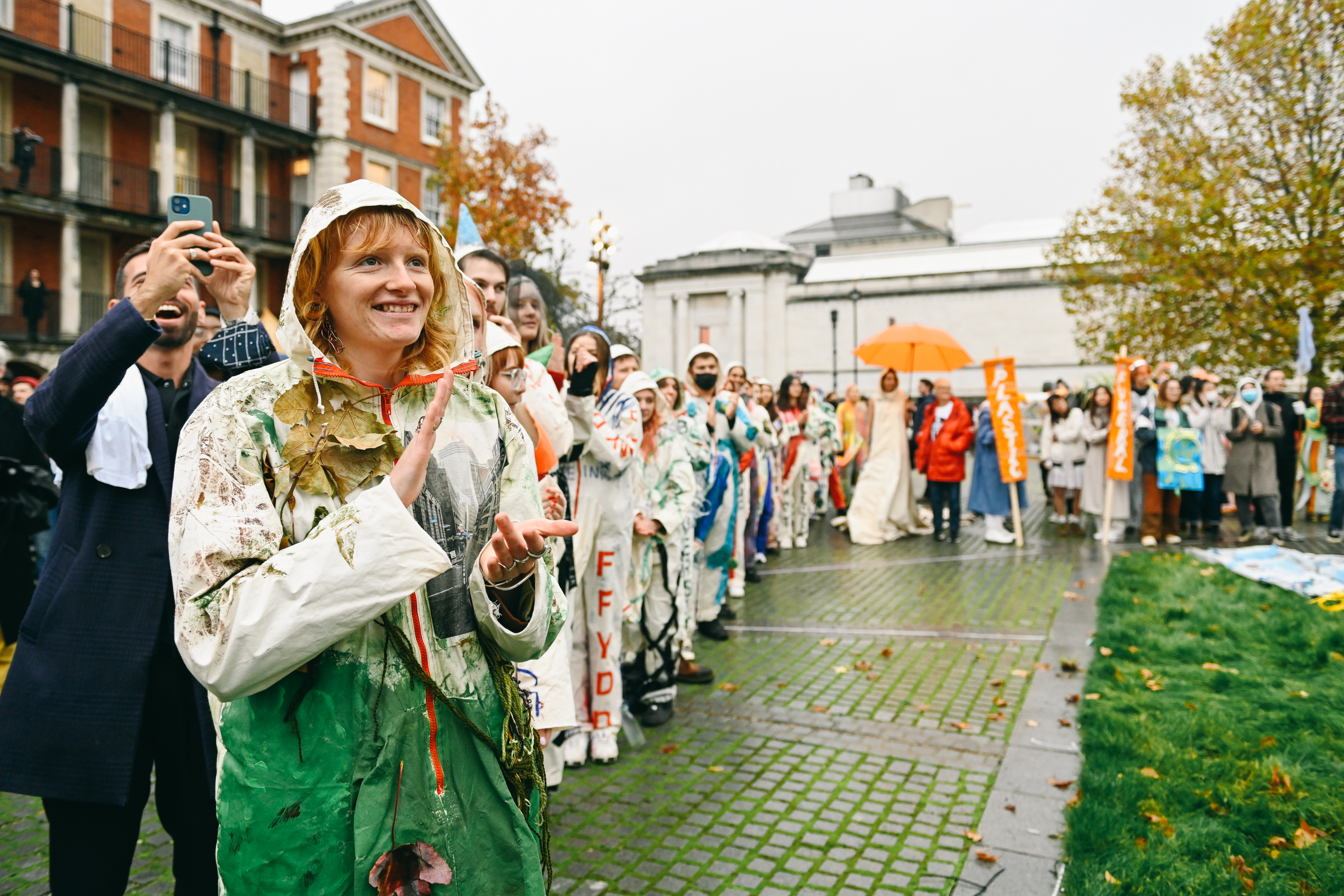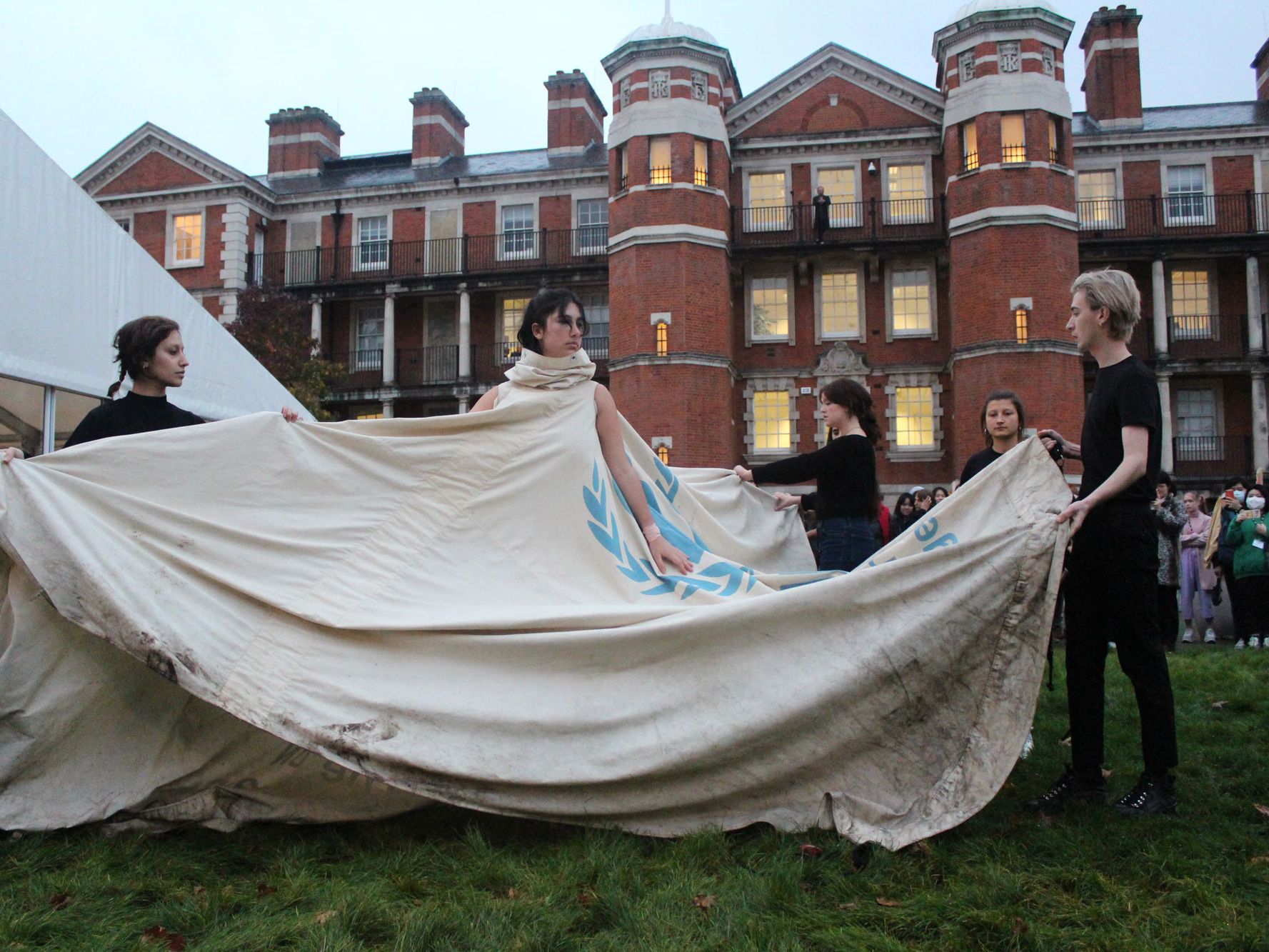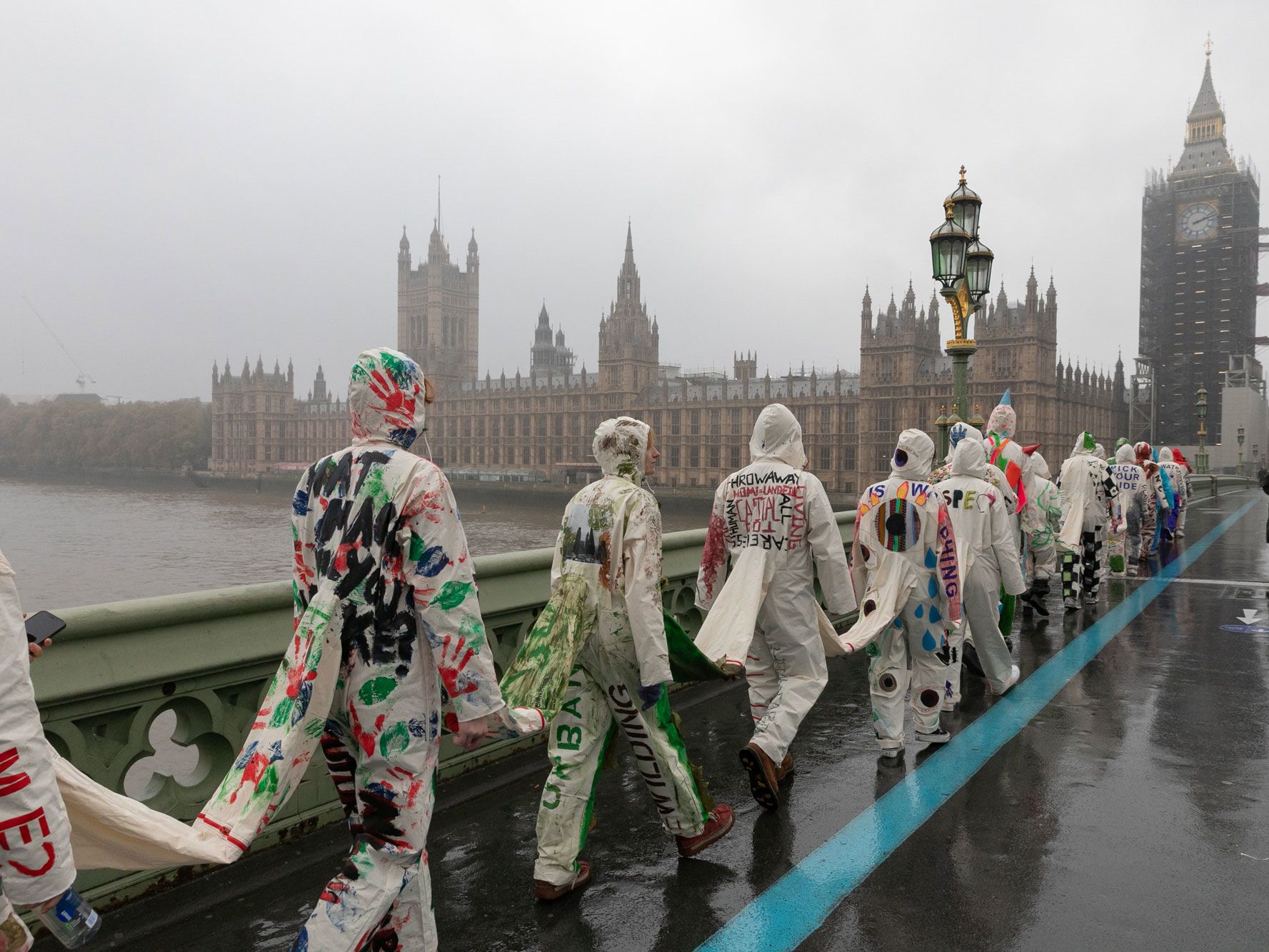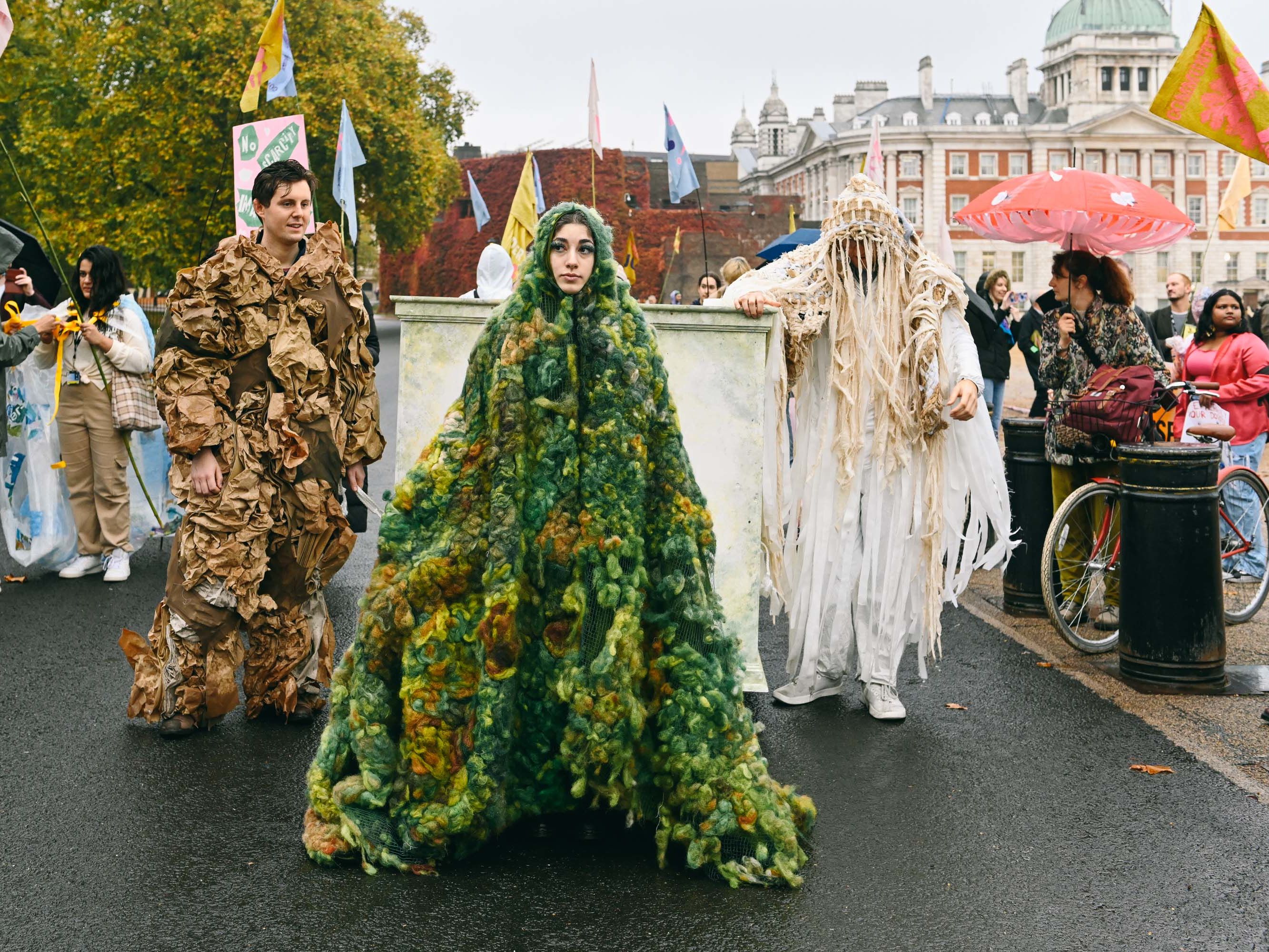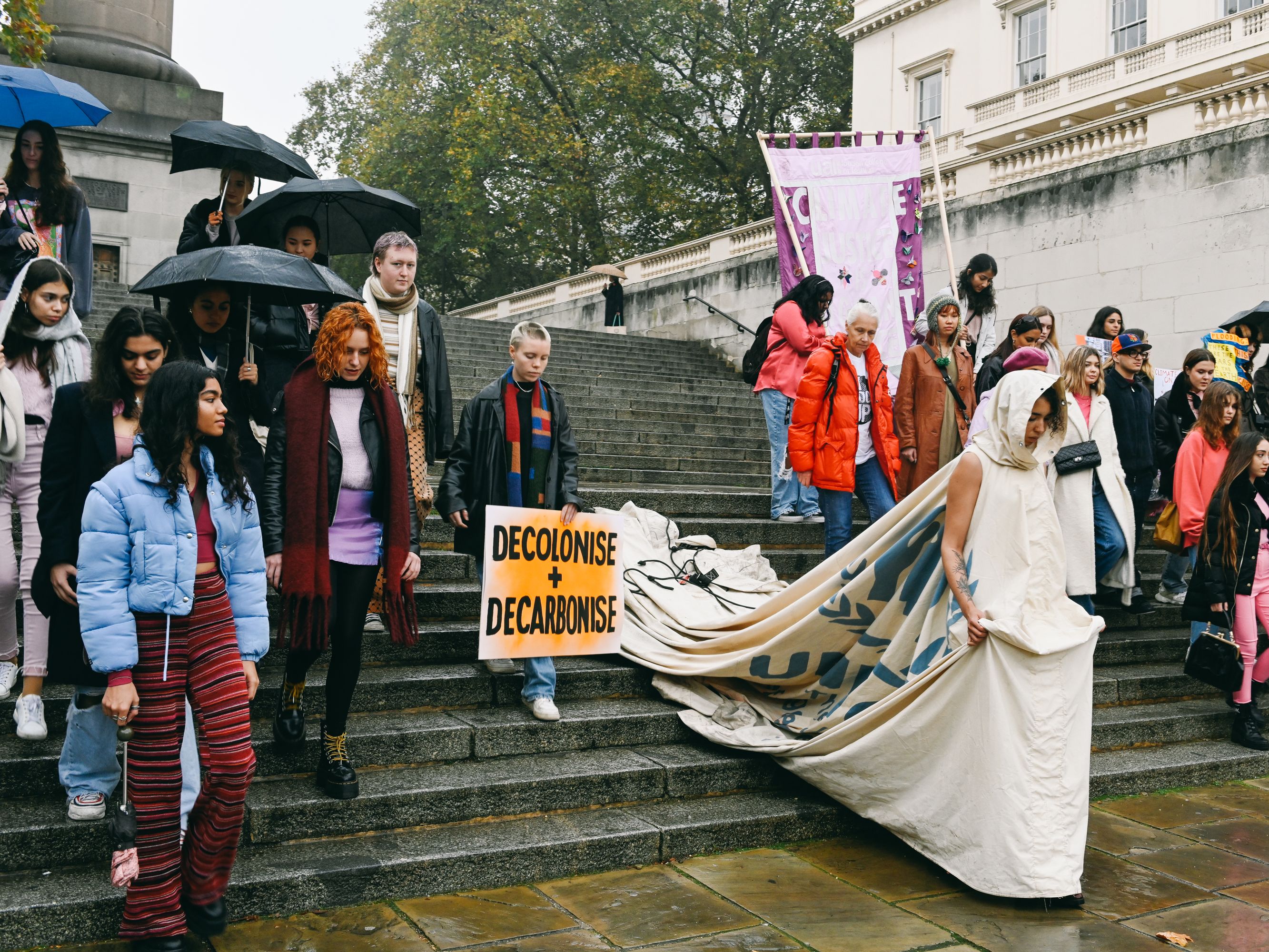Hundreds of UAL students, staff and industry partners came together for Carnival of Crisis: a season of events calling for the arts to mobilise against the climate emergency. Hosted by UAL’s Climate Emergency Network, the 2 weeks of workshops, symposiums and collaborations coincided with COP26 in Glasgow. Participants channeled their collective climate anxieties into finding creative climate solutions, be that through discussions on designing with and for living systems or turning design into an act of caring by regenerating our biodiversity and communities.
On 10 November, colourful reimaginations of a sustainable relationship between nature and the arts were presented at Parade for Climate Justice, where attendees pleaded for ‘solutions, not pollution’ and to ‘decolonise, decarbonise!’. In a Vogue article capturing the event, UAL President and Vice Chancellor James Purnell told the publication: “I’m convinced that creativity is central to climate justice, enabling society to imagine and design a better world.”
So, after 2 weeks of discussing, workshopping and learning about circularity, decolonised climate practices, and so much more, what role do creativity and the arts play in fighting the climate crisis?
“Everything!” Martha Dillon, editor at It’s Freezing in LA! (IFLA) tells us as we catch up with several organisers to reflect on Carnival’s impact. The publication returned to UAL as part of a long-term relationship after being introduced to the multi-disciplinary way in which our students and staff interrogate the creative arts’ involvement in the perhaps biggest challenge facing humanity.
“On an illustrational level, we know our imagery enlivens the text, makes the articles feel present and real, and helps readers navigate complex and abstract ideas. With the workshops [which ran during Carnival], we see participants become better able to engage with the ideas and find a language to process them,” Dillon tells us. “But at the heart of it, creativity and arts are spaces to totally reimagine and inhabit the times we are in, so engagement with climate is essential.”

The climate change magazine hosted two workshops on climate animations and eco-poetry, respectively, and brought a stall to Carnival’s take-over of the Canopy Market in Granary Square, where people were able to grab a copy of IFLA or try out their carbon calculator.
“We absolutely loved seeing the installations take over the main space at [Carnival BASECAMP in] Central Saint Martins. They felt so energetic and urgent, it was amazing to see plastics and waste reimagined into such beautiful structures and experiences. They felt like the perfect carnivalesque precursor to the Parade for Climate Justice and were a really unique and beautiful vision of what a carnival in a climate crisis might look like.”

Collective problems need collective solutions: Transdisciplinarity in creative climate responses
“Embedding the arts in the global response to the climate emergency means reflecting on how the arts can contribute to global and local efforts to avoid worst case scenarios,” Hannah Entwisle Chapuisat, one of the PhD students who contributed to Carnival’s Research within Crisis: Doctoral research responses to climate emergency event, tells us.
During the symposium, UAL doctorate students came together to share their research-in-progress related to ecology, sustainability and climate justice. This included a diverse range of approaches from exploring sustainable consumption methods and presenting culture as the fourth pillar of sustainability as outlined by Professor Ramia Mazé, to Jade McSorely's research on digital fashion to counter fast fashion.

“I noted that Juliana Wescott and I both focus on the role of public policy in addressing climate change, with her research focusing on urban planning process and mine focusing on international law and policy development,” Hannah explains.
“These processes can be enhanced by looking at what unique contributions art and design can make to addressing a particular challenge, issue or process, and working in partnership with others to achieve a common goal - whether that means addressing individuals, communities, nations or the world.”
Embedding sustainability across operations and curriculum is central to UAL’s climate strategy. The event offered a unique opportunity for doctoral researchers at different stages of their career to come together and discuss climate-related topics for the first time, with Dr Meike Schalk from the Royal Institute of Technology in Sweden leading the discussion on relevant topics and methodological questions.

Mazé tells us: “For a general audience, it was a lively and multi-faceted view of relevant research; for the researchers themselves I hope it created a sense of solidarity and a practical network!”
“I was particularly struck by the quality dialogue between Glasgow School of Art (GSA) and UAL within the Carnival of Crisis,” she continues. “GSA in Scotland has obviously been on the frontline of the COP26 debates and actions. With COP26 for the first time in Scotland and on UK ground, it’s terrific that GSA and UAL rallied together to share and develop perspectives, approaches and actions.”
“Creativity and design are such important tools for sustainable transition”, Lauren Junestrand Leal, fellow PhD student and contributor to the event, concludes.
“They help us communicate the climate crisis to the society and explore reactions and feelings surrounding the current situation. It is a way of showing to the world the urgency we are living under.”
Change begins with us: How do arts institutions need to transform to fight the climate crisis?
Arts institutions can help us find solutions but change also needs to happen on our own doorstep: After all, we know that the fashion industry is one of the major global polluters, and by far not the only high-carbon sector in the creative industries. UAL has already begun changing the way we operate to make sure we’re on track to reach net-zero by 2040. If Carnival has taught us one thing, it’s that the creative arts have a unique opportunity to collaborate with others in our climate activism to create change together.
During another Carnival event Collecting in a Climate Emergency, museums, universities and creative practitioners posed the question: What are the ways in which institutions have been collecting activism? And what are the issues around collecting works that address the climate emergency?


“We need to ensure that there is an information pipeline so that students have access to the right resources and information to make informed decisions at every stage of designing and making,” co-chair of the event Judy Willcocks tells us.
“That means museums, libraries, archives, special collections and materials libraries have to work together to create a network of resources that supports curriculum teaching.”
Judy runs UAL’s Climate Emergency Working Group for museums, archives, libraries and special collections across the University. While various organisations are creating tool kits, check lists and advice documents to mobilise for climate action, she admits that Carnival showed the sheer breadth of work already happening across cultural, creative and heritage sectors.
“We need to hook into national and international networks so we can share what others are doing, learn from best practice and position ourselves to contribute to future events and activisms. There is no way we could keep up the energy and intensity of the Carnival indefinitely – but there is so much going on out there we can piggy back on other initiatives and seek to add value.”
Following their joint event during Carnival, the UAL Climate Emergency Working Group is planning another event with Glasgow School of Art and the Glasgow Women’s Library in April 2022 to work out how to make the processes and practices of their sector more sustainable. In the works is also a 10-point Green Manifesto for museums, libraries, archives and special collections at UAL.
Where do we go from here?
As the buzz of COP26 and our Carnival of Crisis simmers down, the next step is to ensure longevity in our climate strategies and make them sustainable in all senses of the word.
The UAL Climate Action Plan outlines our main objectives, including plans to embed climate action into curriculum and students’ practice, co-producing knowledge across disciplines and communities and collaborating with other climate action groups. Never before has the creative engagement of students and creative practitioners of the future been more important in the fight against the climate crisis.

While IFLA’s Martha Dillon emphasises the need for climate action to be a daily endeavour, Judy explains that it’s precisely the arts which gives us the capacity to continually imagine places beyond where we are now.
“Many people find the endless stream of images of forest fires and melting icebergs simultaneously distant and disabling. What is one person to do in the face of so much destruction?” she points out.
“It’s the arts that is able to communicate the extent of the problem in ways we can grasp at a local level. It’s also the arts that can communicate the way back from the brink of destruction.”
“We need to keep sharing knowledge and talking about the climate,” Lauren says.
“We have all seen how COP26 became the topic of talk during the two weeks it lasted. The more we talk about it, the more we explore it, the more we discuss it, the more it will become part of our daily life. It shouldn’t take a COP26 to discuss this issue; the Carnival of Crisis should last the whole year.”
Read more about Carnival of Crisis and all the events that took place across UAL.
Join the Climate Emergency Network.
